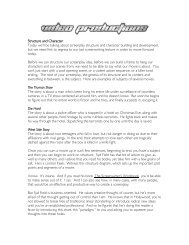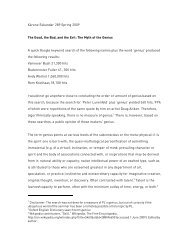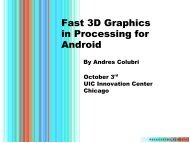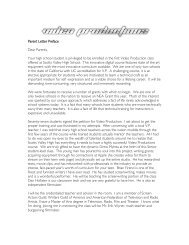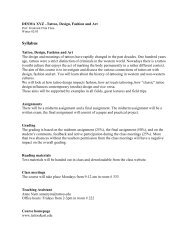UNIVERSITY OF CALIFORNIA Los Angeles - Users - UCLA
UNIVERSITY OF CALIFORNIA Los Angeles - Users - UCLA
UNIVERSITY OF CALIFORNIA Los Angeles - Users - UCLA
You also want an ePaper? Increase the reach of your titles
YUMPU automatically turns print PDFs into web optimized ePapers that Google loves.
4.1. Virtual Process: Data and Tools<br />
Data In his PhD dissertation, Computational Information Design, Ben<br />
Fry proposed seven stages of information visualization in order to make<br />
his process accessible to a wider audience; “a tool is introduced to simplify<br />
the computational process for beginners and can be used as a sketching<br />
platform by more advanced users.” 56 For my thesis project, the first<br />
influential idea concerning this process is the possibility and flexibility to<br />
visualize data as on my own; this led me to the topic I chose for my thesis<br />
project. However, as I stated above, my project is not visualizing data as a<br />
screen-based representation, but as a physical kinetic information<br />
visualization/installation.<br />
For this project, I started with Fry’s stages to explore and manage my<br />
dataset, and the stages that he proposed are as follows:<br />
[A]cquire–Parse–Filter–Mine–Represent–Refine–Interact 57<br />
Figure 37. Initial idea sketches<br />
for rainfall and tide dataset.<br />
1. acquire: the matter of obtaining the data, whether from a file on a disk<br />
or from a source over a network.<br />
2. parse: providing some structure around what the data means, ordering<br />
it into categories.<br />
3. filter: removing all but the data of interest.<br />
4. mine: the application of methods from statistics or data mining, as a<br />
way to discern patterns or place the data in mathematical context.<br />
5. represent: determination of a simple representation, whether the data<br />
takes one of many shapes such as a bar graph, list, or tree.<br />
6. refine: improvements to the basic representation to make it clearer and<br />
more visually engaging.<br />
7. interact: the addition of methods for manipulating the data or<br />
controlling what features are visible.<br />
In my project, I followed 6 stages from ‘acquire’ to ‘refine’. Before<br />
starting the first step, I took an additional step – analyzing datasets to<br />
check the suitability of my project. I needed a dataset that is updating in<br />
real time and is generally from a location. Although my project is not<br />
56<br />
Fry, Ben. “Computational Information design.” PhD diss., Massachusetts Institute of<br />
Technology, Program in Media Arts & Sciences, 2004<br />
57<br />
Fry, “Computational Information design.”, 2004<br />
J.KIM_A LANDSCAPE <strong>OF</strong> EVENTS 44



